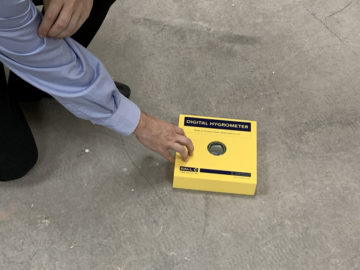Jason Tatton, one of F. Ball’s technical service officers, discusses the variables to consider when determining how to make resilient flooring installations resistant to moisture, including new alternatives to traditional solutions.
Water that is allowed to get beneath resilient floorcoverings can attack adhesives, causing floorcoverings to blister and de-bond and damage subfloors that are sensitive to moisture, such as chipboard. Ultimately, this may result in costly floor failure and recalls. For this reason, F. Ball’s technical service department receives a lot of questions from flooring contractors who are preparing to install floorcoverings in damp or humid locations, including wet rooms. Key to preventing floor failure in these situations is using suitably moisture resistant adhesives and floorcoverings (which depends on how much water they will be exposed to) as well as proper subfloor preparation.
Subfloor prep
As with any floorcovering installation, appropriate subfloor preparation is imperative to ensuring a long-lasting, professional flooring finish and avoiding floor failure.
Before proceeding with any floorcovering installation, make sure that the subfloor is suitably sound, smooth and free of any surface contaminants, including old adhesive residues and non-moisture tolerant smoothing compounds and primers.
In accordance with British Standards, we recommend the use of a pre-calibrated digital hygrometer to measure the relative humidity (RH) levels within the subfloor as part of any floorcovering installation. If subfloor relative humidity levels exceed 75% RH, a waterproof surface membrane will be required.
Floorcoverings
Resilient floorcoverings are an obvious choice for damp and humid environments because they create a barrier between the subfloor and the damaging effects of moisture.
Vinyl planks or tiles may be installed in humid environments, such as domestic bathrooms. However, the installation of vinyl sheet is recommended in wet rooms and other areas where floors will be subject to high levels of moisture, including standing water. In these situations, seams must be welded to ensure a watertight seal and prevent an ingress of water. For the same reason, there should be seals where floorcoverings meet drains or capping and coving at walls.
In any case, floorcoverings and vertical flooring accessories should be installed using a suitably moisture resistant adhesive.
Adhesive selection
Epoxy or polyurethane adhesives have traditionally been the recommended option for making flooring installations impervious to water, inside and outdoors because of their high resistance to water, oil and grease.
The latest advancements in adhesives technology have enabled F. Ball to create a one-part, moisture-curing adhesive for internal and external heavy-duty applications, which is also solvent and isocyanate free: Styccobond F73 PLUS.
The adhesive has been specially developed to provide the high bond strength required to hold a wide range of floorcoverings in place in the most demanding environments, such as in areas subject to surface water, heavy loads and high foot traffic, including in transition areas and entranceways.
Another solution
The arrival of hybrid adhesives, such as Styccobond F49 Hybrid PS, provided another solution for installing resilient floorcoverings in damp and humid environments. As well as being resistant to water, Styccobond F49 offers the familiar characteristics of pressure sensitive adhesives, making it ideal for installing LVTs in these settings.
Excellent resistance to plasticiser migration and high initial grab also makes Styccobond F49 an alternative to contact adhesives for installing vertical flooring accessories, including skirting, capping and coving, which are typically applied to vertical surfaces that may be subject to damp and humid conditions.
